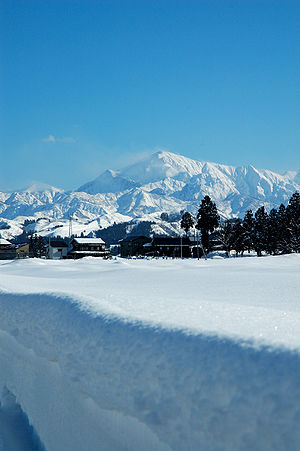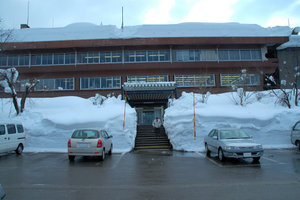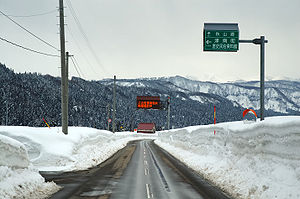
Snow country (Japan)
Encyclopedia



Japan
Japan is an island nation in East Asia. Located in the Pacific Ocean, it lies to the east of the Sea of Japan, China, North Korea, South Korea and Russia, stretching from the Sea of Okhotsk in the north to the East China Sea and Taiwan in the south...
characterized by heavy, long-lasting snowfalls.
The rather poetic can refer to any place with heavy or deep snows and is generally understood as a reference to the Sea of Japan
Sea of Japan
The Sea of Japan is a marginal sea of the western Pacific Ocean, between the Asian mainland, the Japanese archipelago and Sakhalin. It is bordered by Japan, North Korea, Russia and South Korea. Like the Mediterranean Sea, it has almost no tides due to its nearly complete enclosure from the Pacific...
side of Honshū
Honshu
is the largest island of Japan. The nation's main island, it is south of Hokkaido across the Tsugaru Strait, north of Shikoku across the Inland Sea, and northeast of Kyushu across the Kanmon Strait...
(Japan's main island) and the area encompassed by the Japanese Alps
Japanese Alps
The is a series of mountain ranges in Japan that bisect the main island of Honshū. The name was coined by William Gowland, the "Father of Japanese Archaeology," and later popularized by Reverend Walter Weston , an English missionary for whom a memorial plaque is located at Kamikochi, a tourist...
, a series of mountain ranges that make up the island's backbone. In its broadest meaning, snow country means the belt along the Sea of Japan from Yamaguchi
Yamaguchi Prefecture
is a prefecture of Japan in the Chūgoku region on Honshū island. The capital is the city of Yamaguchi, in the center of the prefecture. The largest city, however, is Shimonoseki.- History :...
(in particular, Shimane
Shimane Prefecture
is a prefecture of Japan located in the Chūgoku region on Honshū island. The capital is Matsue. It is the second least populous prefecture in Japan, after its eastern neighbor Tottori. The prefecture has an area elongated from east to west facing the Chūgoku Mountain Range on the south side and to...
) in the south to Honshū's northern tip, as well as Sado Island and Hokkaidō
Hokkaido
, formerly known as Ezo, Yezo, Yeso, or Yesso, is Japan's second largest island; it is also the largest and northernmost of Japan's 47 prefectural-level subdivisions. The Tsugaru Strait separates Hokkaido from Honshu, although the two islands are connected by the underwater railway Seikan Tunnel...
. More narrowly defined, it is used to indicate the area from Fukui
Fukui Prefecture
is a prefecture of Japan located in the Chūbu region on Honshū island. The capital is the city of Fukui.- Prehistory :The Kitadani Dinosaur Quarry, on the Sugiyama River within the city limits of Katsuyama, has yielded the Fukuiraptor kitadaniensis and Fukuisaurus tetoriensis as well as an unnamed...
to Akita Prefecture
Akita Prefecture
is a prefecture of Japan located in the Tōhoku Region of northern Honshu, the main island of Japan. The capital is the city of Akita.- History :The area of Akita has been created from the ancient provinces of Dewa and Mutsu....
, but it is most closely associated with part of Fukui and all of Toyama
Toyama Prefecture
is a prefecture of Japan located in the Hokuriku region on Honshū island. The capital is the city of Toyama.Toyama is the leading industrial prefecture on the Japan Sea coast, and has the industrial advantage of cheap electricity due to abundant water resources....
and Niigata
Niigata Prefecture
is a prefecture of Japan located on the island of Honshū on the coast of the Sea of Japan. The capital is the city of Niigata. The name "Niigata" literally means "new lagoon".- History :...
Prefectures.
"Heavy Snowfall Zones" refers to places where snowfall and snow cover are severe enough to be a hindrance to the livelihood of inhabitants or the development of local industry. In all, more than half of Japan's land area carries the designation—all of ten of the country's 47 prefectures and portions of fourteen others. Heavy snow areas are eligible for subsidies
Subsidy
A subsidy is an assistance paid to a business or economic sector. Most subsidies are made by the government to producers or distributors in an industry to prevent the decline of that industry or an increase in the prices of its products or simply to encourage it to hire more labor A subsidy (also...
and other special consideration from the central government to help them cope with the snow (such as for snow removal
Snow removal
Snow removal is the job of removing snow after a snowfall to make travel easier and safer. This is done by both individual households and by governments and institutions.-De-icing and anti-icing:...
) and otherwise bring stability to local livelihoods and economies.
The heavy snowfalls of Japan's snow country are caused by moisture-laden clouds bumping up against the mountains along the backbone of Honshū and releasing their moisture under the influence of easterly winds blowing off the continent or down from Siberia. As a result, the region includes some of the world's snowiest spots at the same latitudes, as well as the northern hemisphere's southern-most ski resorts; many localities are also frequently visited by avalanches.
Frequently snow
Snow
Snow is a form of precipitation within the Earth's atmosphere in the form of crystalline water ice, consisting of a multitude of snowflakes that fall from clouds. Since snow is composed of small ice particles, it is a granular material. It has an open and therefore soft structure, unless packed by...
is so deep in some places that buildings have a special entrance on their second story; people must remove snow from rooves to prevent its weight from crushing their homes, and special care is taken to protect trees from the snow's weight. In some towns, people used to tunnel paths to one another's homes, and streets were lined with covered sidewalks to ensure that people could get around. Today in areas where temperatures are high enough to make it practical, many roads are equipped with sprinklers using warm ground water to keep them passable by melting the snow.
The most recent record snows were brought by the blizzards of December 2005–February 2006, when well over 3 m (4.5 m in one part of Aomori Prefecture
Aomori Prefecture
is a prefecture of Japan located in the Tōhoku Region. The capital is the city of Aomori.- History :Until the Meiji Restoration, the area of Aomori prefecture was known as Mutsu Province....
) of snow accumulated in many rural areas, and anywhere from 46 cm (Tottori
Tottori, Tottori
is the capital city of Tottori Prefecture in the Chūgoku region of Japan.As of 2006, the city has an estimated population of 200,974 and a density of 262.48 persons per km². The total area is 765.66 km²....
) to nearly 1.5 m (Aomori
Aomori, Aomori
is the capital city of Aomori Prefecture, in the northern Tōhoku region of Japan. As of 2009, the city had an estimated population of 302,068 and a density of 366 persons per km². Its total area was 824.52 km².- History :...
) piled up even in several major cities.
One striking feature of Japan's snow country are the on . These are trees frozen by winds from Siberia
Siberia
Siberia is an extensive region constituting almost all of Northern Asia. Comprising the central and eastern portion of the Russian Federation, it was part of the Soviet Union from its beginning, as its predecessor states, the Tsardom of Russia and the Russian Empire, conquered it during the 16th...
and covered in snow, giving a ghostly impression.

